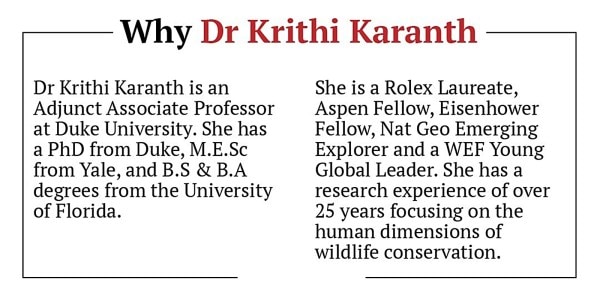Dr Krithi K Karanth is Chief Conservation Scientist and Executive Director at Centre for Wildlife Studies, an internationally recognised Centre of Excellence in the arenas of wildlife research, in-situ conservation, policy and education.
With an experience of over 25 years, Krithi has conducted interdisciplinary research assessing species distributions and extinctions, impacts of wildlife tourism, consequences of voluntary resettlement, land use change and understanding human-wildlife interactions resulting in more than 75 scientific publications.
Krithi spoke to indianexpress.com on the challenges of using tech for wildlife conservation, the use of AI, drones and the growing field of bioacoustics in wildlife conservation, and the innovations being carried out at the Centre for Wildlife Studies, Bengaluru. Edited excerpts:
Krithi Karanth: Use of tech in wildlife conservation is not something new. Even during the 1920s in India, we had Frederick Walter Champion, an officer of the Imperial Forestry Service and others experimenting with camera traps to document wild animals in India. It was considered a very innovative tech then. This was scientifically formalised and applied in research by the Centre for Wildlife Studies led by Dr K Ullas Karanth who established the scientific field methods and statistical modelling approaches to study and estimate the population of a variety of animals. Such camera traps were used to track animal population size, movements of tigers, leopards and elephants across the country.
Nowadays, acoustic monitoring and eDNA are being used to track very large level changes in land use, poaching and logging which have both wildlife and environmental implications.
The field of bioacoustics is exploding, where devices are “listening” to a variety of bats, birds and other wildlife to assess distribution and behaviour.
Along with satellite technology, there has been a growth in applications of drones to understanding various ecological questions. There is also the work going on in the mapping of land using drones. This is useful in tracking land cover, land use and tree growth. Drones are used in Africa to track wild animals over large tracts of land. However, one must understand that such drone usage is harder in forested areas in India, as there would be tree and forest cover, which would hinder tracking of wildlife.
Artificial intelligence has grown by leaps and bounds in the field of wildlife tracking. The AI models need to use valid field observations so that we are not inputting noise and junk data. However, at the end of the day, human monitoring is needed.
Krithi Karanth: An interesting project that we are doing is with acoustic devices where we are trying to map and build an elephant call library, a kind of database of elephant calls. This collaborative project can identify a variety of elephant noises and is being used to build an alert system to help mitigate human-elephant conflict. Sometimes elephant rumbles are similar to a motorbike and then we need to differentiate the same. Rainforest Connection is our partner in the project and it is a leader in the tech for wildlife segment across the world.
While the earlier one was quite high-tech, there are also other examples of our work. With one of our initiatives, Wild Seve, we have built a data portal of human-animal conflict with a toll free number for the villagers to report the conflict, which has a coverage of 1500 villages and seven national parks. Using this data portal, we have responded and enabled the filing of more than 24,000 claims in which we have helped villagers get compensation or payments from the governments in various states. It is not being done online. This programme has been instrumental in addressing around eight years of human-wildlife conflict in India.
We partner with a lot of tech companies who believe that tech is the only solution to wildlife issues, but it still needs the involvement of people.
Krithi Karanth: Tech in wildlife works very well as a pilot but it faces innumerable challenges on the ground. Pilots get done, but we find that there would be no scaling of these ideas and long term project implementation. We work with a lot of tech companies where exciting ideas are discussed but may never get implemented.
We have done some hackathons too with tech companies. There is a lot of excitement from the participants, but unless you go to the field, and try to implement the same and iterate based on experience, it does not work.
Hence these interesting tech ideas stop at some level. We must understand that the hardware and the software too takes time to develop and needs to be validated in the field. One needs to be patient.
We have co-developed data portals, but the challenge is to sustain it over a period of time. Sometimes in the field of wildlife conservation, it takes decades for these ideas to mature and be validated but what we have seen is that the long term execution of such concepts is poor.
However, there are individual scientists in India, who are working with very advanced tech in their own way.
Tech would be of great use in anti-poaching efforts, tracking criminals involved in the wildlife trade and detection of patterns involving criminals and others involved in poaching.
Krithi Karanth: For a case study in conservation and conflict management, and using tech in a minimal and sustainable manner, you can take the example of the management of human-elephant conflict in Valparai, in Tamil Nadu by the Nature Conservation Foundation. With simple and effective lighting, an elephant is detected and SMS messages are sent to people in the surrounding vicinity which leads to reduction of conflict situations. This is not done by us, but it shows how very basic tech interventions can resolve many issues on the ground.
Krithi Karanth: In India, we have camera traps usage going up to a large extent and it is now being used to track leopards, tigers and elephants. GIS, remote sensing and mapping are areas where we see a lot of action. Also with satellite imagery becoming an open source product, it is easily available and cheap. So that too is being used extensively.
There are some who are working with sensors to look at road traffic and wildlife mortality, where wildlife is run over by cars or trucks. The idea is to track and prevent such incidents. But such projects are at an early stage, and there are questions about their scalability.
Krithi Karanth: There is a lot of potential in the tech sector in India, but we should move beyond hackathons. Wildlife conservation cannot just be a hobby. Perhaps there is a need for more capital and investment in the same. Also we should look at large organisations outside the country which are devoting themselves exclusively for Tech for Wildlife like our partner Rainforest Connection or others who institute substantial prizes for tech work done in the field of wildlife. Only then, something substantial will emerge.

 Venkatesh KannaiahVenkatesh Kannaiah is indianexpress.com's consulting editor for South … read more
Venkatesh KannaiahVenkatesh Kannaiah is indianexpress.com's consulting editor for South … read more
We are using AI to build a database of elephant calls on the field: Krithi Karanth, Executive Director, Centre for Wildlife Studies – The Indian Express

